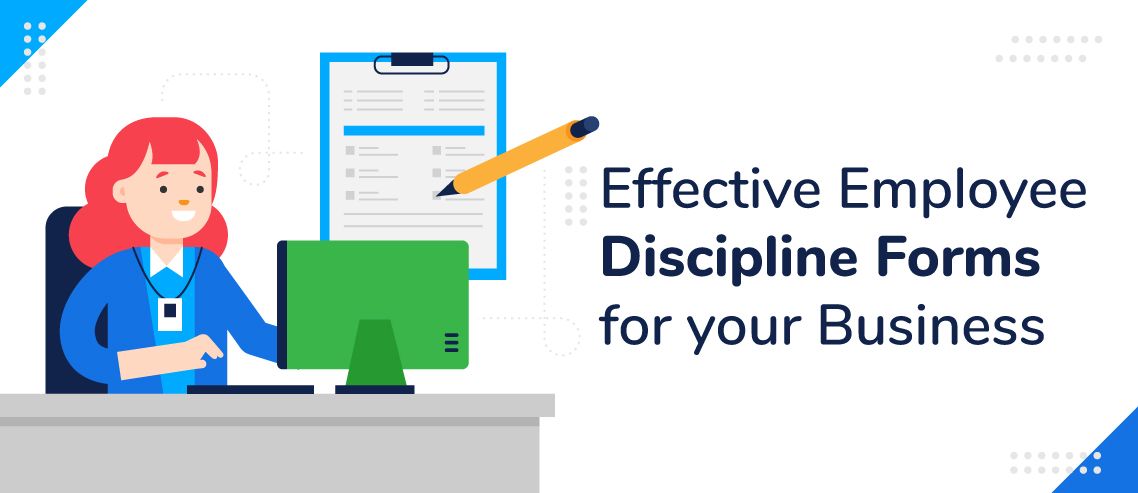4 Effective Employee Discipline Forms for your Business

Disciplining employees can sometimes be a necessary part of running a company or managing a team.
In order to protect your business from legal ramifications when disciplinary procedures go wrong, it’s important to implement a process to follow when an employee is not acting or working according to the expectations set out in their contract or employee handbook.
Although there are variations, the disciplinary procedure generally follows four steps:
– Verbal warning
– Written warning
– Final written warning
– Suspension and/or dismissal
When you need to convey a warning in writing or track the disciplinary process, employee discipline forms can be very useful. They ensure that each manager is following the same process and is giving the employee in question all the information they need – and that the process is documented should a legal dispute arise.
We’ve compiled four of the most useful written discipline forms to help you determine which is right for your business.
What Is an Employee Discipline Form?
An employee disciplinary action form is designed to inform an employee that they are not following the policies or expectations set by their employer and remind them of the consequences of their actions.
Depending on the form, and the stage at which it is used in the disciplinary process, there may also be space for a statement from the employee and the criteria their manager expects them to meet in order to exit the disciplinary process and continue working for their employer.
Why Are Employee Discipline Forms Useful?
Employee discipline forms are very helpful – if not necessary – for several reasons. Namely, they:
– Provide a detailed record of an employee’s past behavior at work
– Protect against legal liability
– Facilitate progressive discipline
– Set firm standards for managers
– Give employees structure
If you aren’t already using discipline forms as part of your disciplinary procedure, consider whether it would make sense for you to start. The following forms are general categories and can be tailored to your particular needs.
4 Examples of Effective Employee Discipline Forms
1. Employee Written Warning Letter

An employee written warning letter – used at the second stage of the standard disciplinary procedure – can easily be customized to fit your situation. This form provides written proof of the infraction that took place and records the manager’s desire for such behavior to change. If a verbal warning has previously been given, it will also outline this, as well as its effect on the employee’s behavior.
An employee written warning letter should also include the consequences facing the employee. Even if the issue is minor, it’s useful to have the situation on record – especially if disciplinary action needs to be pursued with the employee down the line.
This letter is sent directly to the employee and requires no input from them, although you may choose to have them sign it.
2. Employee Disciplinary Action Form
This form is useful for when the employee challenges the manager’s perception of events. It can be used at the beginning of the process to note that the employee is being put through the organization’s disciplinary process.
However, it’s also useful to have as a general record of the situation. One of the major benefits of this type of form is that it can contain space for both an employer’s and employee’s statement, allowing you to go into as much detail as necessary and to record the recipient’s response.
From the employee’s perspective, this may offer a fairer way of recording the event and ensures an in-depth account of the incident in question, so details aren’t forgotten down the line.
3. Employee Suspension Letter
After a verbal warning and two written warnings, the next step for an employee failing to improve their behavior may be suspension.
This often occurs as part of the dismissal process: an employee may be asked not to come into work while their case is discussed by the relevant parties. This will then either lead to the termination of their contract, full reinstatement in their role, or conditional reinstatement.
A suspension letter should include:
– The details of the infraction, including times and dates
– Exactly how this infraction breached company policy and/or their contract
– Reference to any meetings management has already had with them surrounding the issue
– Any rules they must adhere to during their suspension, such as not contacting other employees
– What will happen within the company while they’re off, such as an investigation into their case
– Next steps, like when they can expect to find out the results of any investigations into their behavior
– Their pay arrangements during their suspension
– Contact details in case they have any questions surrounding the information in the letter
4. Performance Improvement Plan (PIP)

While not a discipline form per se, a performance improvement plan, or PIP, can be a helpful follow-up for employees who are going through – or have been through – a disciplinary procedure. It’s also useful for managers who don’t want to put an employee through a full-scale disciplinary procedure but do need to see their performance improve.
A PIP is a formal document stating any recurring performance issues, along with goals that an employee needs to achieve in order to regain good standing at the company (usually with a specific timeline to complete the plan). This holds the employee accountable when it comes to improving the performance issue a manager has identified and encourages improvement.
However, if they fail to achieve the aims of the PIP – depending on the seriousness of the issues – the manager may then decide to begin the official disciplinary procedure. In this instance, a PIP will provide thorough and solid documentation to support this decision.
What does your disciplinary procedure look like and which forms have proven the most helpful? Share your experience in the comments.
JD enjoys teaching people how to use ZoomShift to save time spent on scheduling. He’s curious, likes learning new things everyday and playing the guitar (although it’s a work in progress).



